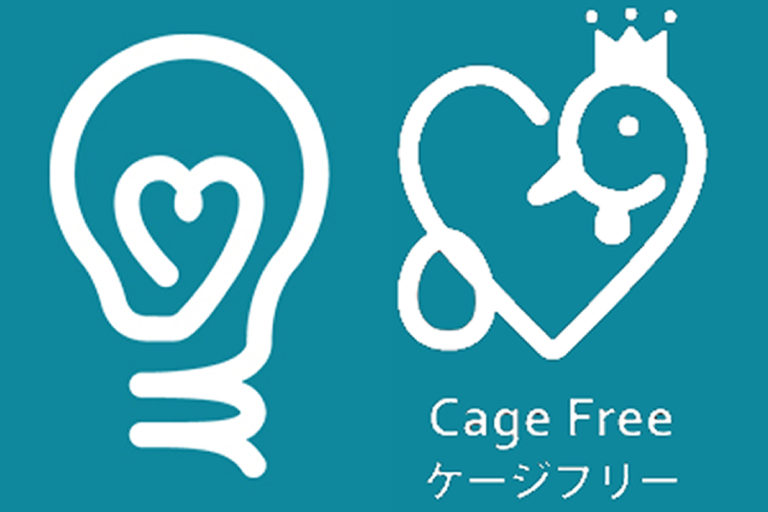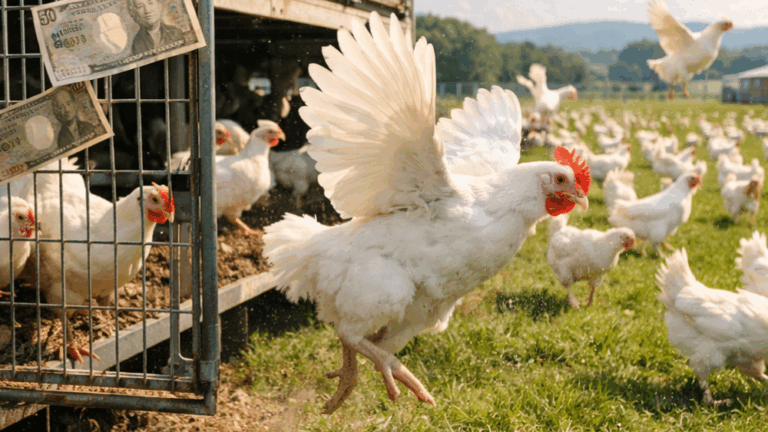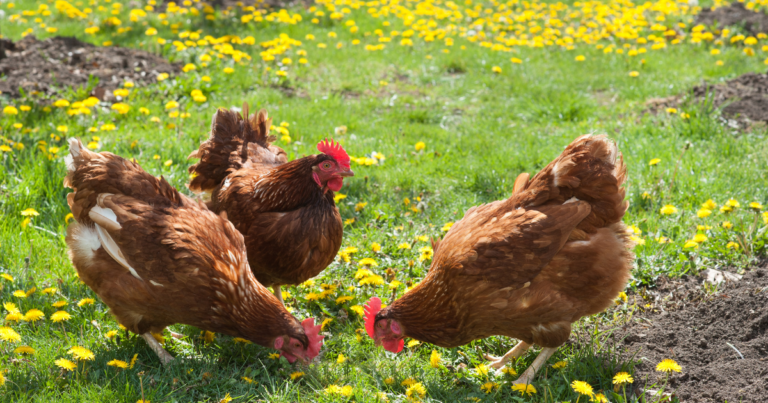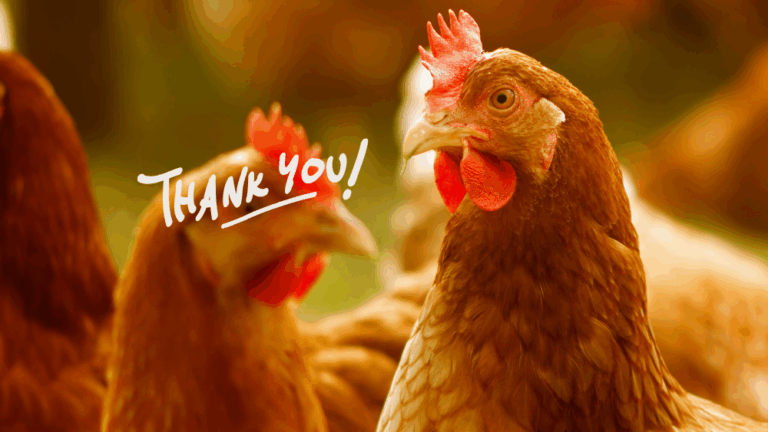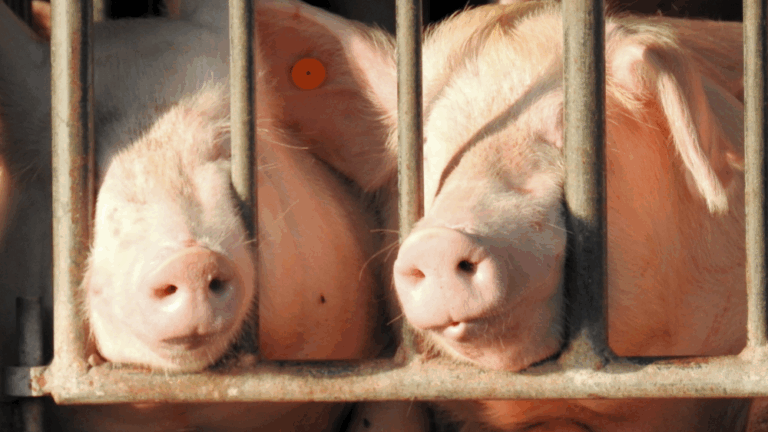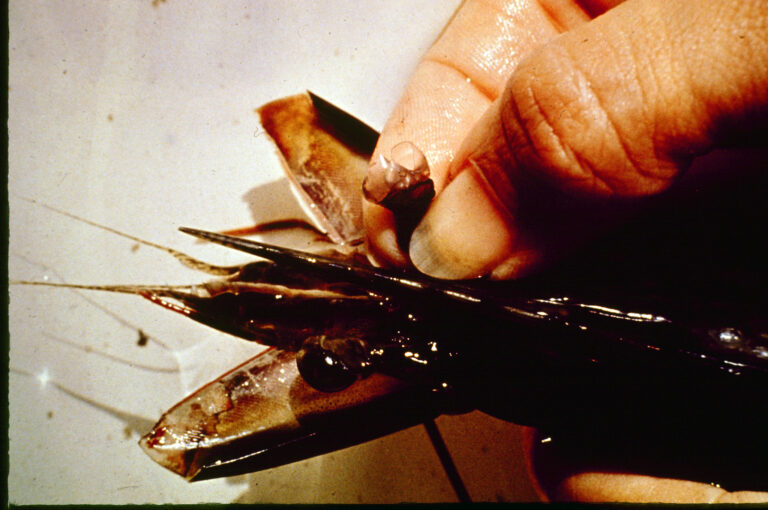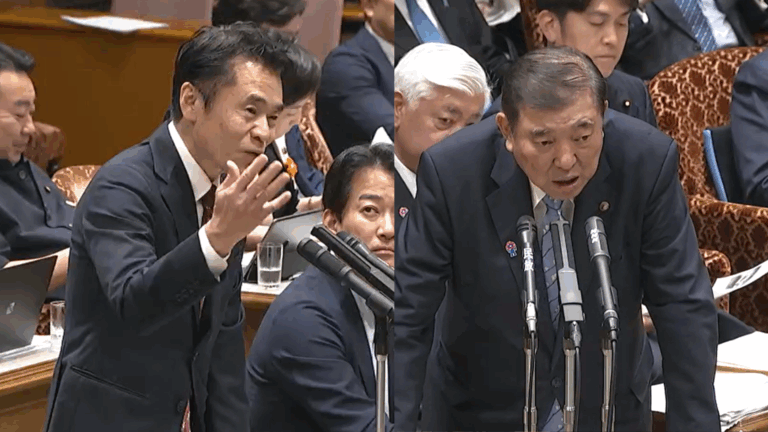Originally written by Luis Costigan of Effective Altruism Japan, modified by Yuki Takahashi.
Summary
- Farm animal welfare is considered a high-priority cause area by the Effective Altruism community due to the sheer scale, neglectedness, and tractability of the problem.
- Egg-layer hens are the most farmed animals both globally and in Japan (excluding fish). The number is similar to that of humans.
- Over 99% of layer hens in Japan are reared in battery cages.
- Battery cages are plausibly extremely bad; many sources have evaluated a life in a battery cage to provide the lowest levels of welfare across all farmed land animals.
- Campaigning for corporations to source eggs from cage-free producers has been historically successful, plausibly affecting 240-390 million layer hens per year globally.
- A dollar spent on corporate cage-free campaigns can potentially affect 12-160 years of chicken life.
- There are organizations that are still working on generating cage-free pledges from corporations that still have room for further funding; you could potentially have a big impact by donating.
What is Effective Altruism (EA)?
The world has many problems, many different ways of solving these problems, and only limited resources.
The Effective Altruism movement seeks to figure out, of all the possible uses of these resources, which uses produce the most good, impartially considered1.
Why focus on farm animal welfare?
As an input to prioritize cause areas for which resources could be used, EA adopts the following “INT” framework:
Importance: How many people (and sentient beings) are affected by an issue and by how much?
In Japan for example, there are as many as 182 million egg-laying hens and 138 million broiler chickens. In comparison, there are 9 million pigs, 1.7 million beef cattle, and 0.77 million dairy cows2,3.
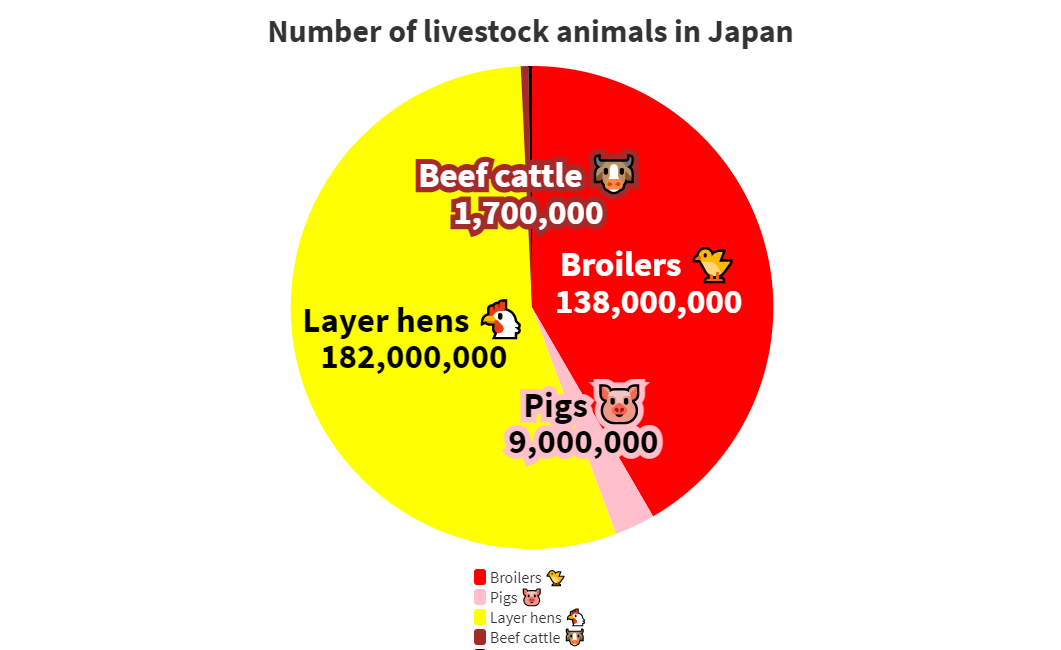
Intuitively, depriving an animal of basic needs (e.g. keeping a chicken in a cage) could cause immense suffering. In estimating the scale of suffering, however, it is important to acknowledge a degree of uncertainty; there have been some efforts to understand the scale of animal suffering on factory farms:
- How good is The Humane League compared to the Against Malaria Foundation? (EA Forum)
- 2017 Report on Consciousness and Moral Patienthood (Open Philanthropy Project)
Neglectedness: What degree of resources are already focused on resolving an issue?
While the scale is immense, the amount of resources dedicated to reducing suffering on factory farms is relatively small. According to Animal Charity Evaluators, 99.6% of animals used and killed in the US exist on farms, but only 0.8% of donations go to charities working on farm animal welfare4.
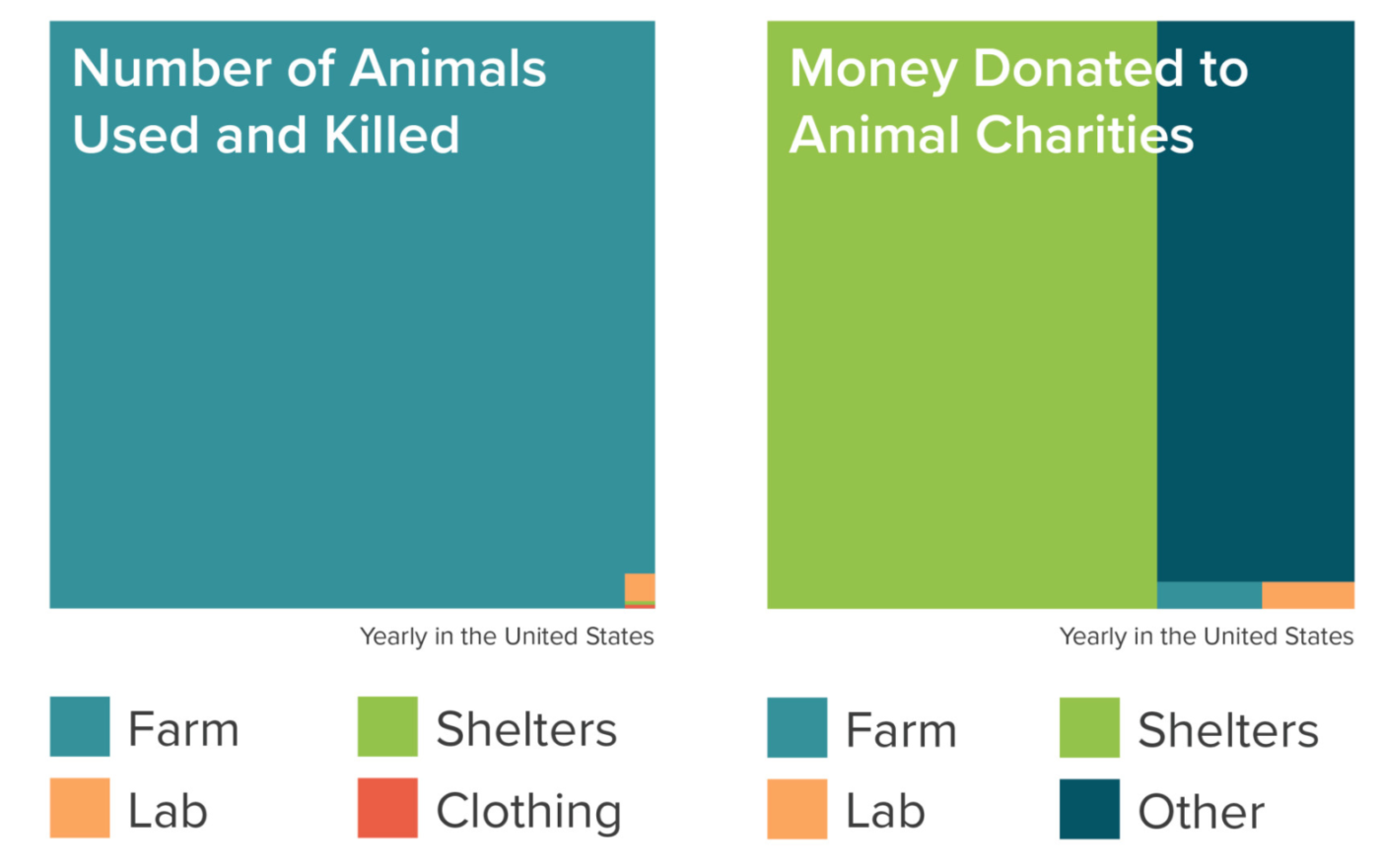
Tractability: How easy is it to make progress resolving an issue?
With successes seen in the promotion of alternative protein, political advocacy and corporate campaigning among others, there are some plausible ways to make progress.
The focus on battery-caged hens
Number of battery-caged hens – Global
This study suggests that the global population of layer hens is between 6.1 billion (International Egg Commission) and 7.6 billion (FAOSTAT), not too different from the human population.
The proportion of layer hens in battery cages depends on location; RSPCA Australia suggests that around 66% of layer hens live in battery cages, while the proportion of layer hens in battery cages in the US has decreased from 94% in 2014 to 80% in 20195.
Number of battery-caged hens – Japan
Around 182 million layer hens are reared in Japan2, and over 99% of the egg-laying adults appear to be kept in battery cages6.
Welfare of battery-caged hens – Global
Largely referencing Cause Area Report: Corporate Campaigns for Animal Welfare (Pages 20-23)
A life in a battery cage is plausibly extremely bad. Hens are kept in tiny spaces, live on wire racks, are unable to move around, and are kept from engaging in natural behaviors such as foraging, dust-bathing, and socializing7.
There have been attempts to estimate layer hen welfare in battery cages:
- Charity Entrepreneurship’s weighted animal welfare index gives battery caged hens a -57 out of a scale from -100 to +100, the joint worst score on their scale along with factory farmed turkeys8. It factors in criteria such as death rate/reason, human preference (from behind the veil of ignorance), and disease/injury etc9.
- In “Compassion, by the Pound”, F. Bailey Norwood gives caged egg-laying hens a welfare score of -8 (again, the worst score on his scale) and cage-free egg-laying hens a score of +2 (see Table 8.2 on p. 229)10.
- In estimates by other research as well, the welfare of battery caged layer hens are rated about the worst compared to other farmed animals11.
| Farmed animal welfare index (-10 to +10) | Norwood 2011 | Shields | Warren 2018 | Norowitz | Savoie et al 20188 (Humans: +3.2-8.1) | Tomasik 2018 Multiples of suffering |
| Beef cattle | +6 | +2 | +6 | +6 | -2.0 | ×1 |
| Dairy cow | +4 | 0 | 0 | -4 | -3.4 | ×2 |
| Cage-free layer hen | +2 | -7 | -7 | (Enriched cage -4.6) | ||
| Farmed fish | -7 | -5 | -7 | -4.4 | ×1.5 | |
| Pig | -2 | -5 | -5 | -10 | ×2.5 | |
| Turkey | -8 | -6 | -11 | -5.7 | ×3 | |
| Broiler chicken | +3 | -8 | -6 | -13 | -5.6 | ×3 |
| Battery-caged layer hen | -8 | -7 | -8 | -25 | -5.7 | ×4 |
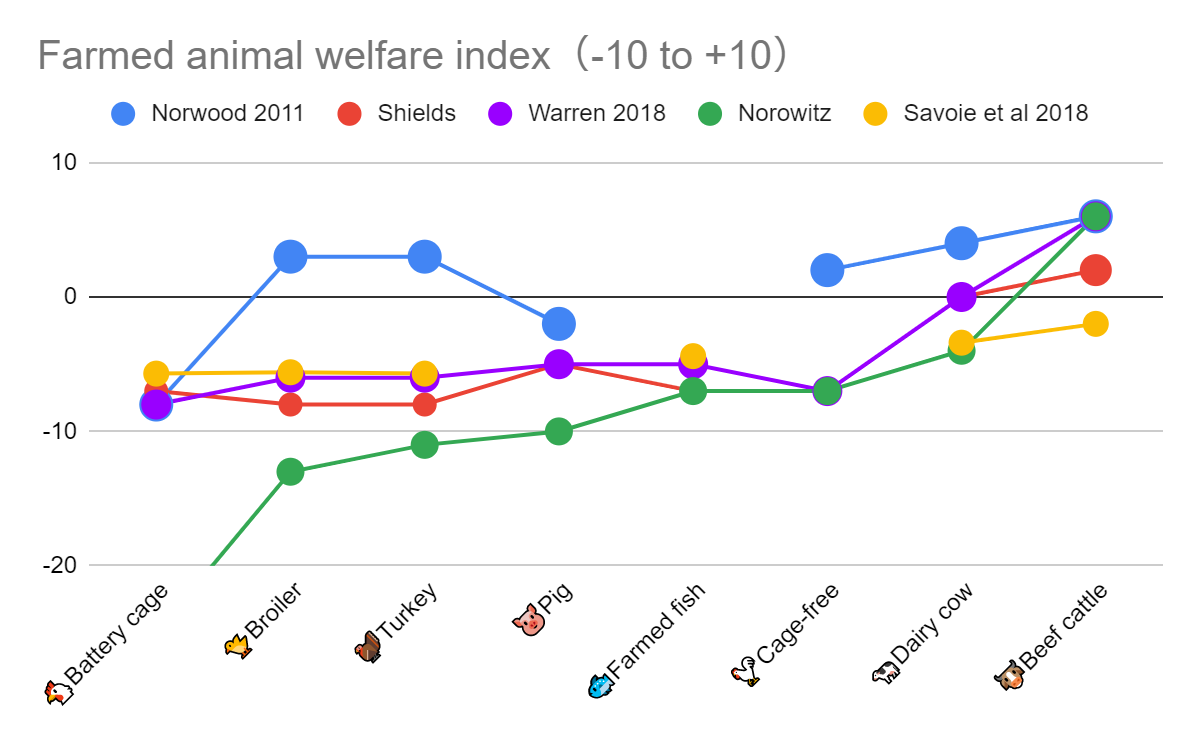
Welfare of battery-caged hens – Japan
In short, a battery cage in Japan is no different from battery cages elsewhere.
A survey on the state of layer hen farming by the Agriculture and Livestock Industries Corporation yielded the following key points (n=398 farms, 55% response rate):
- 8.1% of farms keep over 500,000 hens at any one time, 0.5% keep more than 3 million.
- Of the poultry houses managed across all respondents, 60.2% were open and the remaining 39.8% were windowless.
- Across all 3,094 poultry houses with cages, just 12 (0.3%) used enriched cages.
- 240 houses used no cage (free-range or open)12
A rearing space of 430-555 cm2 is recommended per hen by the Japan Livestock Technology Association (2016)13, meaning that the layer hens are trapped their whole lives inside an area only 21-23 cm on a side at best.
The recommended temperature inside a poultry shack should be between 20-30℃13, but this depends on whether the structure is a windowless or open poultry shack. Another recommendation is to observe the state of the birds at least once per day13, but there are cases in which many cages are stacked on top of each other (in some cases as many as 14) which would make it very difficult to check the state and temperature of each bird in every corner.
Challenges specific to Japan
The following was written after chatting with Maho Cavalier (The Humane League Japan).
Farm animal welfare awareness, education, and expertise are all lacking in Japan compared to the state of the movement in the West. This is mirrored in Japanese policy-making. In 2020, the Animal Protection Index gave Japan a “G” (the lowest possible) rating for “Protecting Animals used in Farming”14.
Japanese business culture creates some barriers to progress, including a low tolerance for risk and the requirement for group consensus in decision making (see a take on this by McKinsey here).
Elsewhere, neither the Japanese government nor banks/trading houses offer financial incentives to go cage-free. From a practical standpoint, cage-free eggs can also be difficult to obtain and supply to far-out locations.
What can be done to improve the lives of layer hens?
Abolitionism vs Incrementalism
Some approaches to improving animal welfare can be described as abolitionist, based on an understanding that any use of animals is unjustified and should be abandoned entirely.
While we can adopt an abolitionist standpoint as an individual (i.e. by going vegan), it would be extraordinarily difficult to adopt this as a society (i.e. by outlawing animal use entirely) given its current state.
On the other hand, incrementalist approaches like improving animal welfare or reducing animal product consumption can be applied on a society level (as well as on a personal level as a flexitarian). While incrementalist approaches may have to concede that they aren’t completely morally justified, their likelihood of success means that outcomes could be much better in expectation.
Corporate cage-free campaigns
Animal welfare groups including The Humane League have been engaging in campaigns to request corporations to pledge that, by a specified time, they will source their eggs from layer hens that have not been reared in any type of cage.
Such campaigns have historically been very successful, the graph below showing how many companies have made pledges to transition to cage-free in the US and internationally15.

The Humane League has played a major role in getting corporations to undertake cage-free pledges and is currently recommended as a top charity by Animal Charity Evaluators.
While very approximate, Lewis Bollard of Open Philanthropy Project gave his subjective 90% confidence intervals for the number of animals impacted by cage-free pledges16:
- 210–270 million hens used by companies that made cage-free commitments in the U.S17.
- 100–300 million hens used by companies that made cage-free commitments in other countries.
What is the alternative to battery cages?
Open Philanthropy Project (OPP) believes that most US egg producers will switch to indoor multi-tier aviary systems if they transition away from battery cages18. After investigating the difference in welfare between battery cages and aviary systems in this article, OPP appears to believe tentatively that aviary systems are better for layer hens for the following reasons:
- Each hen will be provided with 1.6 to 2.1 times as much space, as well as some degree of ability to perch, forage, dustbathe, and nest (none of which are possible in a battery cage, and all of which appear to be valuable according to hens’ revealed preferences in the research we have seen so far).
- Although increased mortality rates were seen in aviary systems, producers have a financial incentive to reduce mortality on their own.
- Only a fraction of layer hens are affected by higher mortality rates, while all receive the behavioral benefits.
How cost effective are cage-free campaigns?
There are two excellent posts on the Effective Altruism forum with relation to this question that are definitely worth reading:
This post from EA-affiliated research organization Rethink Priorities suggests that each dollar spent on corporate cage-free campaigns (including their supporting activities) plausibly affects 12 to 160 years of chicken life.
Against Malaria Foundation (AMF) is considered one of the most cost-effective charities19. It is important to acknowledge difficulty and uncertainty when comparing the effectiveness of organizations working on the welfare of humans vs other animals. Quoting from the post below:
“In this model, in most of the most plausible scenarios, THL appears better than AMF. The difference in cost-effectiveness is usually within 1 or 2 orders of magnitude. Under some sets of reasonable assumptions, AMF looks better than THL. Because we have so much uncertainty, one could reasonably believe that AMF is more cost-effective than THL or one could reasonably believe that THL is more cost-effective than AMF.“
“In general, if you value human well-being >10,000 times more than chicken well-being, AMF looks better. If you value human well-being <300 times more than chicken well-being, THL looks better.“
Potential for more funding
As of November 2020, Animal Charity Evaluators estimates that The Humane League has room for an additional $660,000 in 2021 before reaching diminishing returns, and that additional funds would be used to expand the team in Japan20. This indicates how important cage-free movement in Japan is. Additional funding for corporate campaigns would help to secure more pledges and ensure that pledges are implemented, saving a significant number of hens from lifetimes trapped in cages.
It’s not just funding. Supporting corporate cage-free efforts as a volunteer or as one consumer raising voices is one of the most effective actions one can take to reduce suffering of the animals.
Further Information
If the above has sparked or rekindled an interest in improving the lives of layer hens or farmed animals in general, the following resources are recommended:
Animal Charity Evaluators, who aspire to find and promote the most effective ways to help animals.
Open Philanthropy Project, who have done extensive research on farm animal welfare as a cause area and have provided grants to various projects.
- Condensed from a paper by Will MacAskill on “The Definition of Effective Altruism”.
- https://www.e-stat.go.jp/stat-search/files/data?sinfid=000031878327&ext=pdf
- Fish are not included in this list and could plausibly be farmed in much higher numbers and in worse conditions. For more information, see: https://www.fishwelfareinitiative.org/
- https://animalcharityevaluators.org/donation-advice/why-farmed-animals/
- https://www.openphilanthropy.org/blog/will-companies-make-good-cage-free-pledges
- https://www.hopeforanimals.org/eggs/235/
- https://founderspledge.com/research/fp-animal-welfare Page 20-23
- https://docs.google.com/spreadsheets/d/1dWzh0Se0nhbPxe2Ye3o-tr3BoOBtdiCbMkpPuw2rBFE/edit#gid=14772511
- https://docs.google.com/document/d/1VYfWgqCQFmGNrtTyroXYRhrWaTaqFcf4pRHctl6URlw/edit
- Relying on information provided by the “How good is The Humane League compared to the Against Malaria Foundation?” blog post.
- https://stephenwarrenorg.files.wordpress.com/2018/08/suffering-by-the-pound-meat-and-animal-product-harm-comparisons5.pdf
- http://jlta.lin.gr.jp/report/animalwelfare/shishin/layers_28.9.pdf
- 平飼い (free-range), 放し飼い (open) – These terms are used in the survey but are not well-defined.
- https://api.worldanimalprotection.org/country/japan
- https://forum.effectivealtruism.org/posts/uNo7qLBn5ErjYwBmd/lewis-bollard-lessons-learned-in-farm-animal-welfare
- https://forum.effectivealtruism.org/posts/L5EZjjXKdNgcm253H/corporate-campaigns-affect-9-to-120-years-of-chicken-life
- The confidence interval is relatively narrow, partly because USDA has independently arrived at similar estimates, probably using a similar methodology. According to a 2018 USDA report, 230 companies that pledged to go cage-free in the U.S. together use about 225 million hens every year, which is nearly 70% of the U.S. flock.
- https://www.openphilanthropy.org/focus/us-policy/farm-animal-welfare/how-will-hen-welfare-be-impacted-transition-cage-free-housing
- https://www.givewell.org/charities/top-charities
- https://animalcharityevaluators.org/charity-review/the-humane-league/


